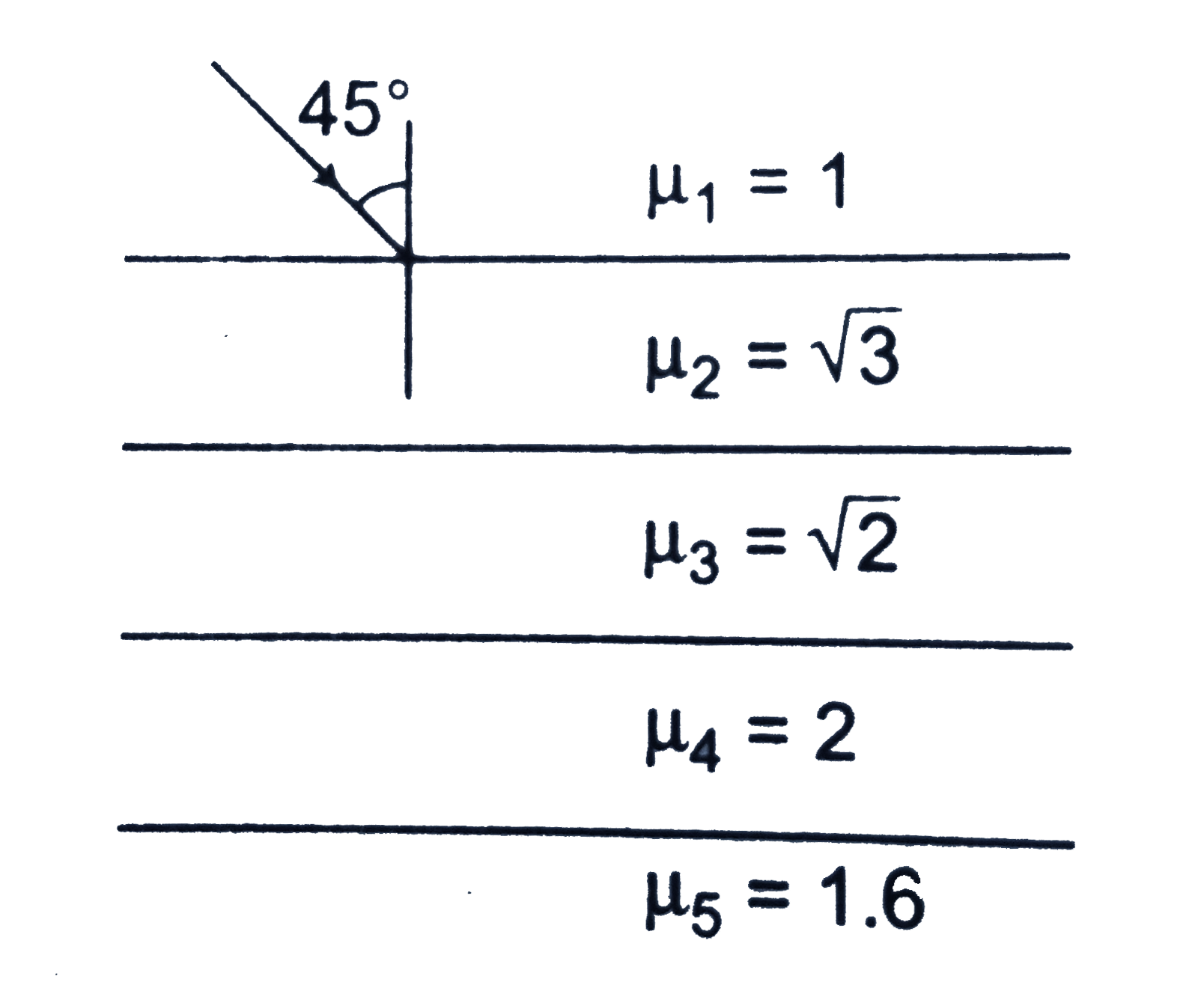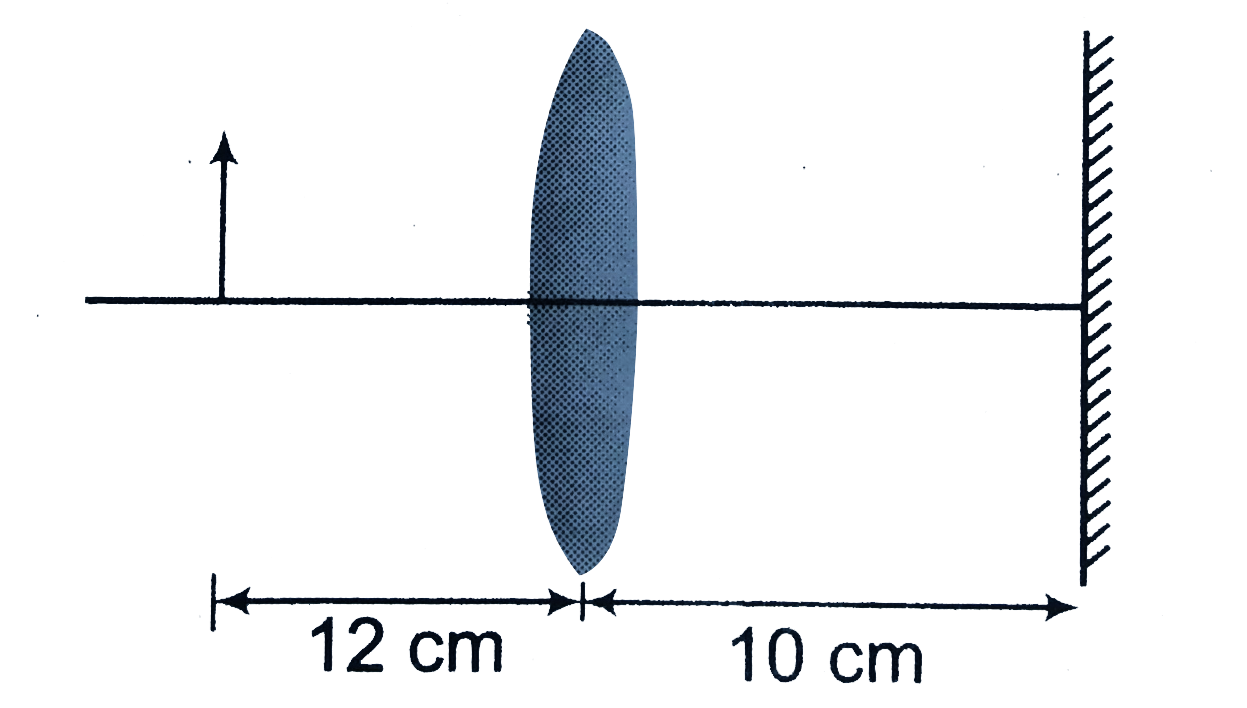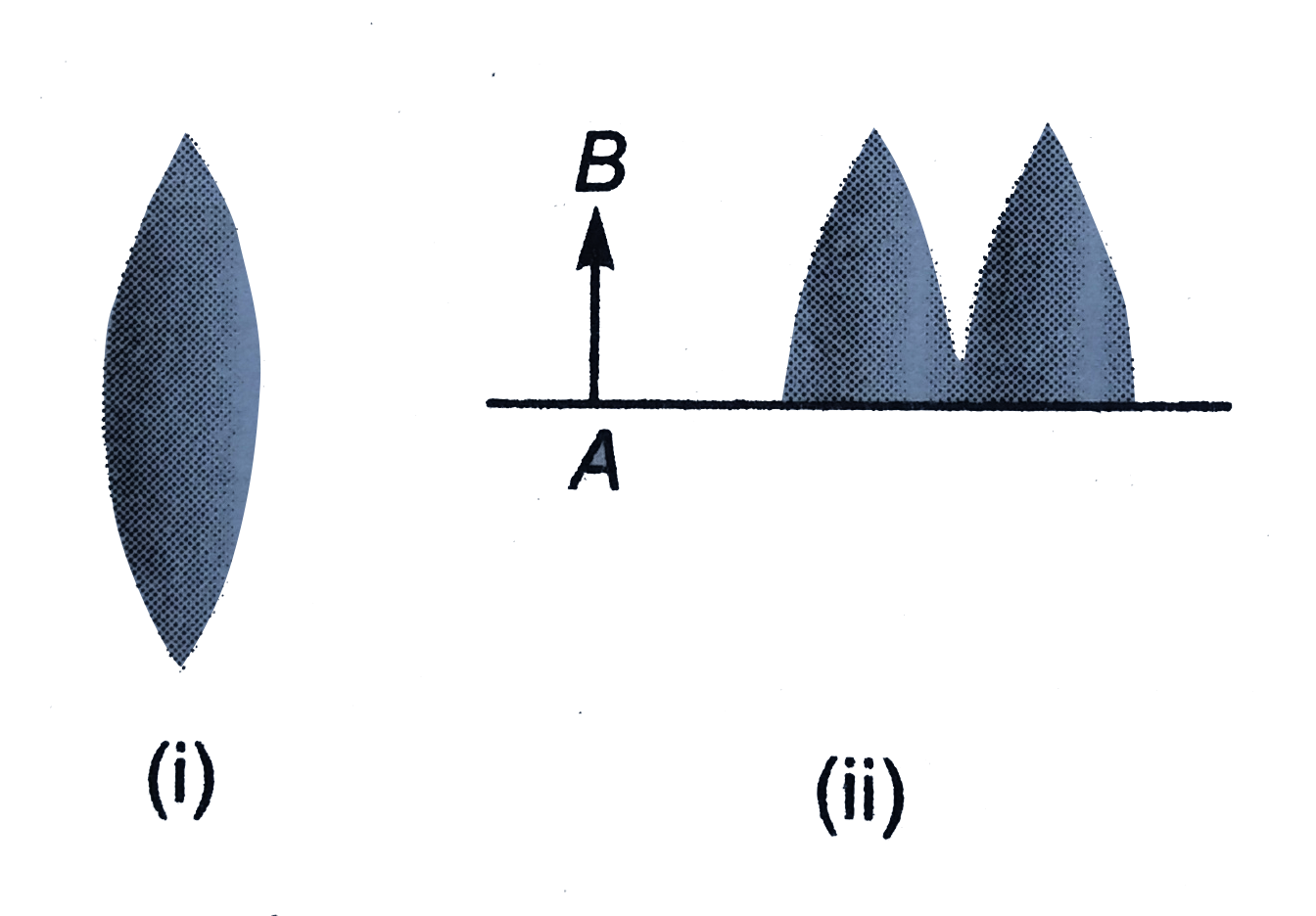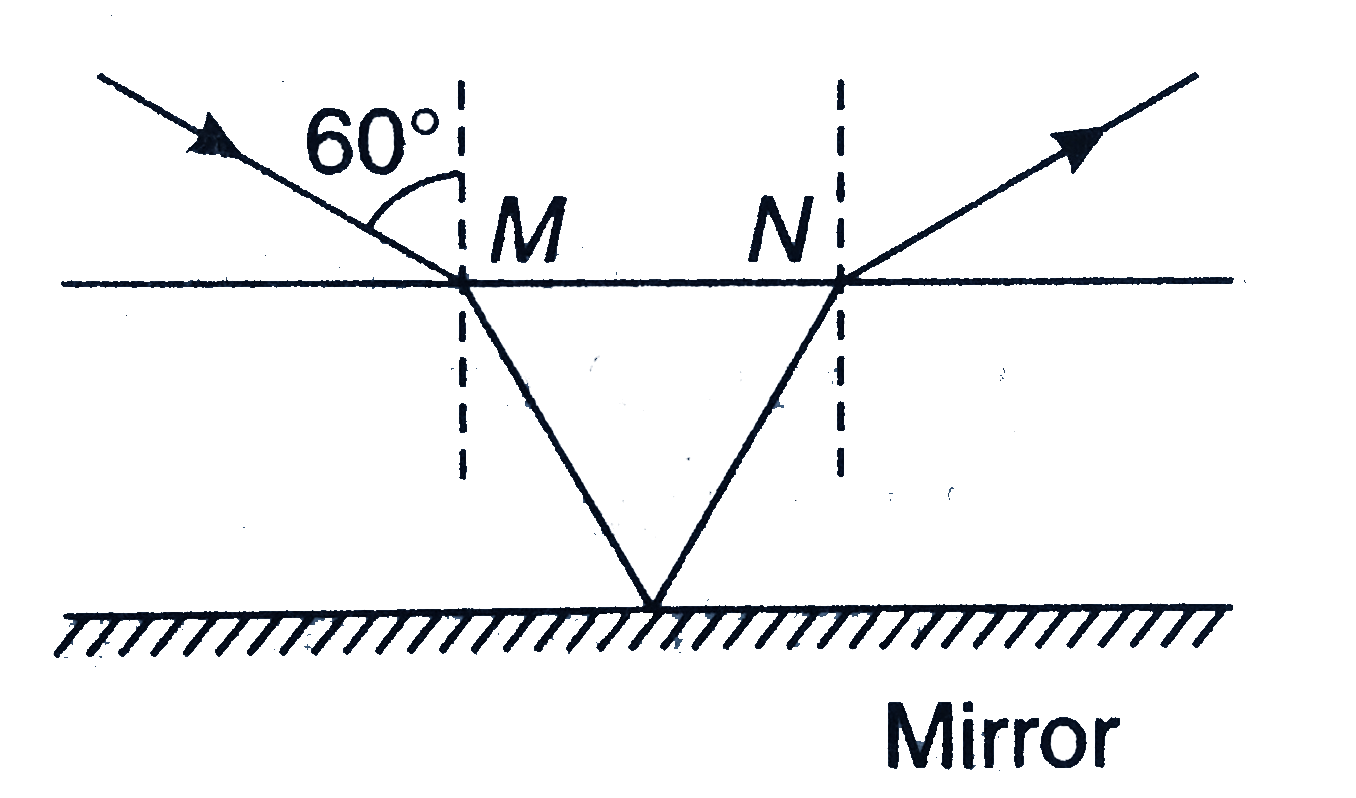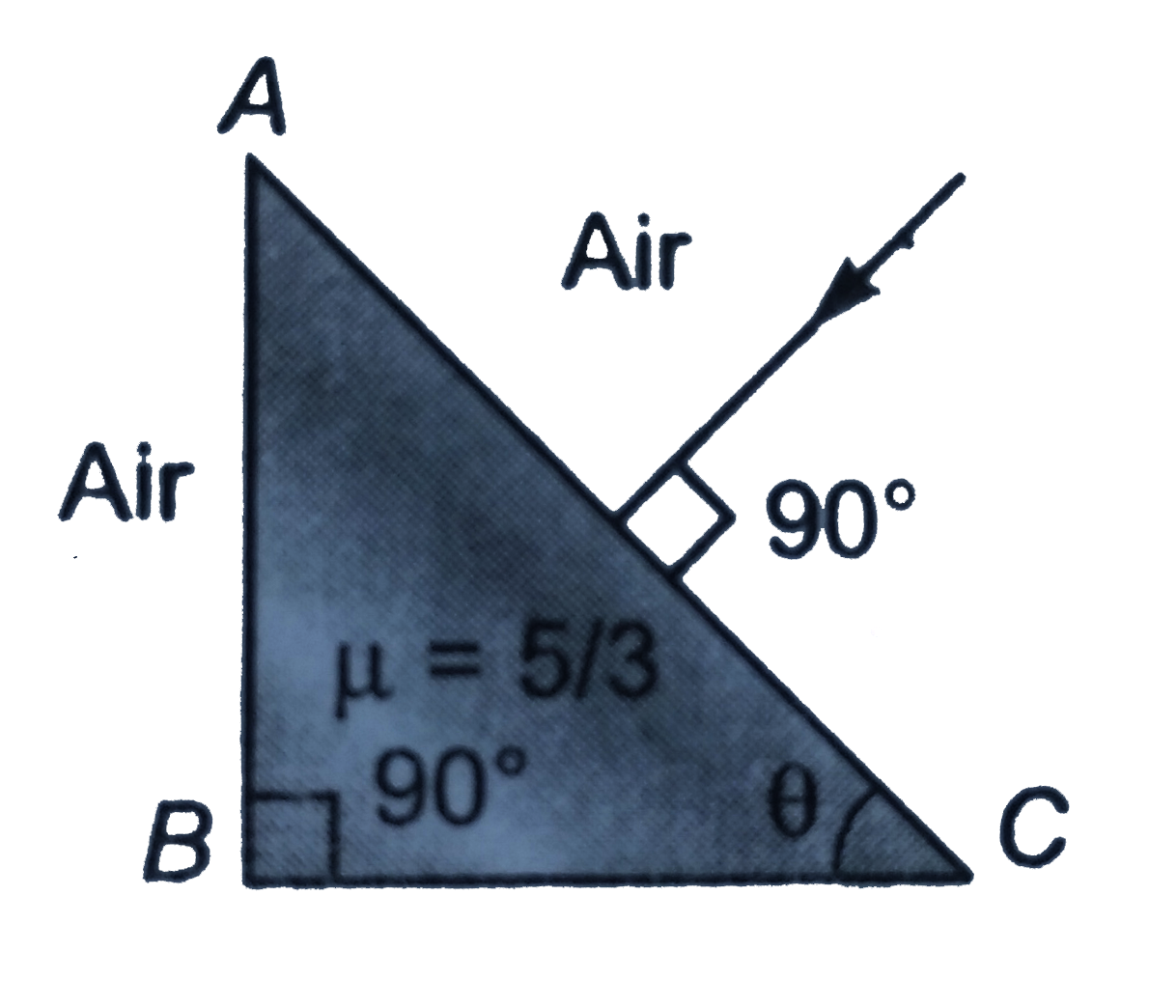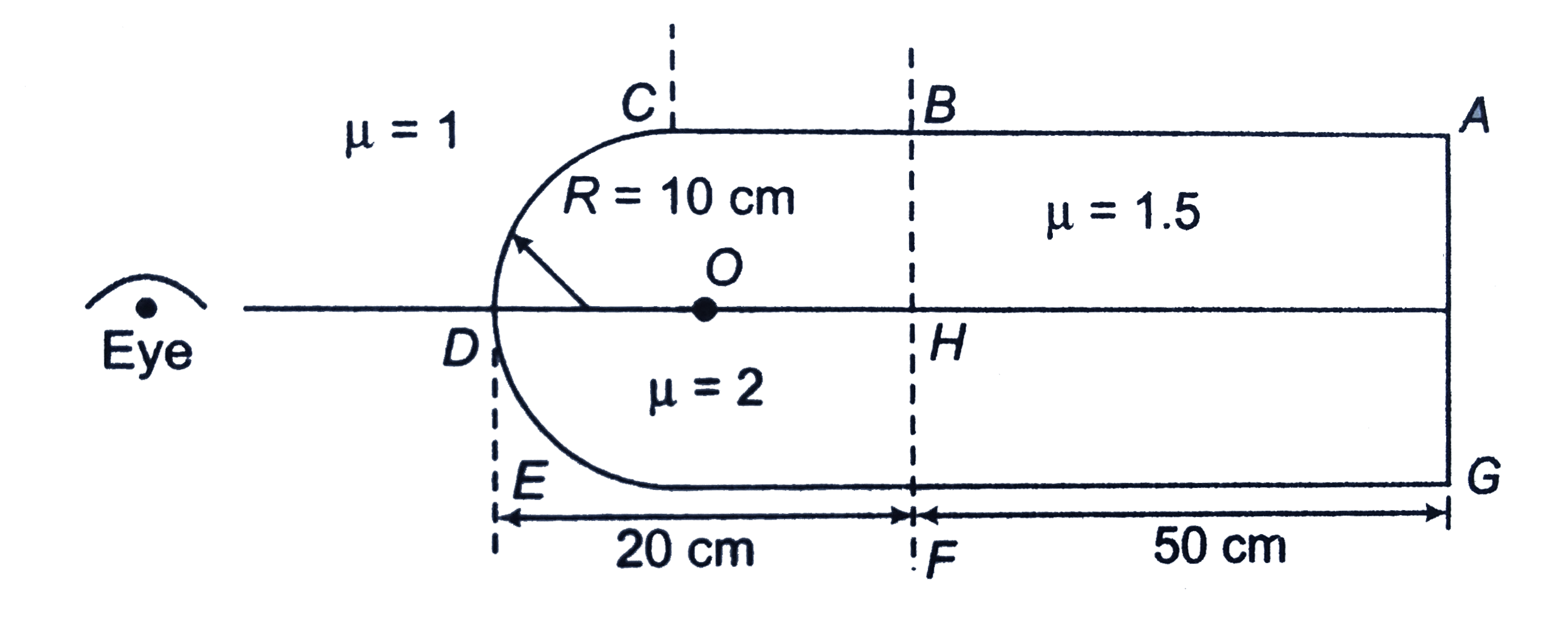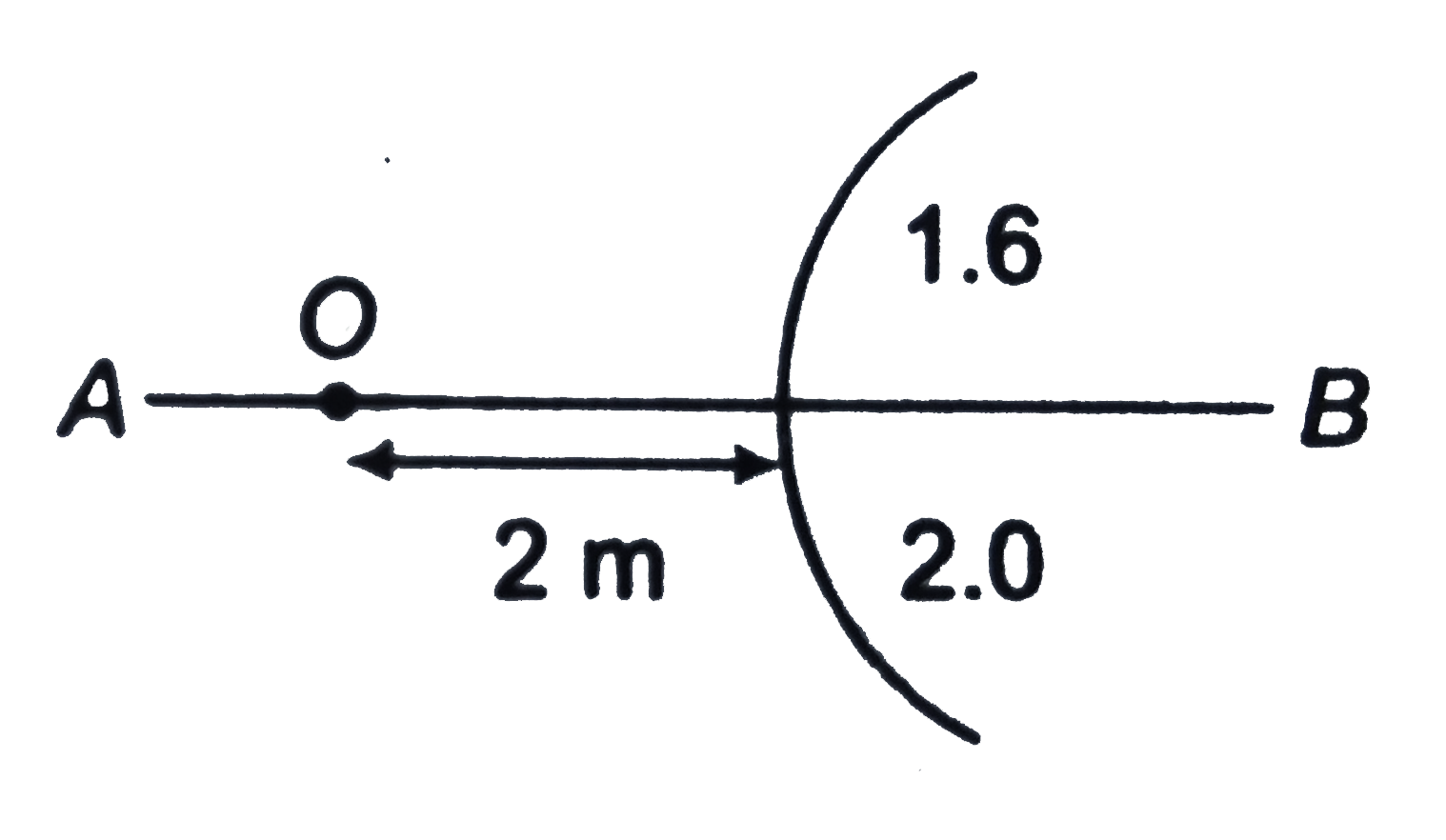Subjective Questions from DC PANDEY ENGLISH REFRACTION OF LIGHT for Class 12
| Class 12 | PHYSICS |
| Chapter | REFRACTION OF LIGHT |
| DC PANDEY ENGLISH | Subjective Questions |
| Medium | English |
| Academic Year | 2023-2024 |
Question 17
A diverging lens is made of material with refractive index 1.3 and has identical concaves surfaces of radius 20cm. The lens is immersed in a transparent medium with refractive index 1.8.
(a) What is now the focal length of the lens?
(b) What is the minimum distance taht an immersed object must be from the lens so that a real image is formed?View SolutionQuestion 21
When a pin is moved along the principal axis of a small concave mirror, the image position coincides with the object at a point 0.5m from the mirror. If the mirror is placed at a depth of 0.2m in a transparent liquid, the same phenomenon occurs when the pin is placed 0.4m from the mirror. find the refractive index of the liquid shown in fig.
 View Solution
View SolutionQuestion 30
A glass vessel in the shape of a triangular prism is filled with water, and light is incident normally on the face xy. If the refractive indices for water and glass are 4/3 and 3/2 respectively, total internal reflection will occur a the glass-air surface xz only for sinθ greater than
A 1/2
B 2/3
C 3/4
D 8/9
E 16/27
 View Solution
View SolutionQuestion 33
A ray of light is incident at an angle of 60∘ on the face of a prism having refracting angle 30∘. The ray emerging out of the prism makes an angle 30∘ with the incident ray. Show that the emergent ray is perpendicular to the face through which it emerges and calculate the refractive index of the material of prism.View SolutionQuestion 45
Assertion:A convex lens and a concave lens are kept in contact. They will behave as a diverging lens if focal length of convex lens is more.
Reason: Power of a concave lens is always less than the power of a convex lens, as power of concave lens is negative whereas power of convex lens is positive. View SolutionQuestion 47
Assertion: In the figure shown |R1|>|R2|.Two point objects O1 and O2 are kept at same distance from the lens. Image distance of O1 from the lens will be more compared to the image distance of O2.

Reason: If medium on two sides of the lens is different, we cannot apply lens formulae directly.View SolutionQuestion 48
Assertion: White light is incident on face AB of an isosceles right angled prism as shown. Colours, for which refractive index of material of prism is more than 1.414, will be able to emerge from the face AC.

Reason:Total internal reflection cannot take place for the light travelling from a rarer medium to a denser medium.View SolutionQuestion 63
A ray of light, travelling in a medium of refractive index 'mu_, is incident at an angle i on a composite transparent plate consisting of three plates of refractive indices μ1,μ2andμ3. The ray emerges from the composite plate into a medium of refractive index μ4, at angle x. Then, View SolutionQuestion 81
A point object is placed at a distance of 12cm from a convex lens of focal length 10cm. On the other side of the lens, a convex mirror is placed at a distance of 10cm from the lens such that the image formed by the combination coincides with the object itself. The focal length of the convex mirror is View SolutionQuestion 90
The laws of reflection or refraction are the same for sound as for light. The index of refraction of a medium (for sound) is defind as the ratio of the speed of sound in air 343m/s to the speed of sound in the medium.
What is the index of refraction (for sound) of water (v=1498m/s)?
What is the critical angle θ, for total reflection of sound from water?View SolutionQuestion 92
A light beam of wavelength 600nm in air passes through film 1(n1=1.2) of thickness 1.0μm,then through film 2(air) of thickness 1.5μm, and finally through film 3(n3=1.8) of thick≠ss1.0mu m.
(a) Which film does the light cross in the least time, and what is that least time?
(b) What are the total number of wavelength (at any instant) across all three films together? View SolutionQuestion 98
A shallow glass dish is 4.00cm wide at the bottom as shown in figure. When an observer's eye is positioned as shown, the observer sees the edge of the bottom of the empty dish. When this dish is 4.00cm wide at the bottom as shown in figure. When an observer's eye is positioned as shown, the observer sees the edge of the empty dish. When this dish is filled with water, the observer sees the centre of the bottom of the dish. Find the height of dish μw=4/3.
 View Solution
View SolutionQuestion 99
A glass prism in the shape of a quarter cylinder lies on a horizontal table. A uniform, horizontal light beam falls on its vertical plane surface as shown in the figure. If the radius of the cylinder is R=5cm and the refractive index of the glass is n=1.5, where on the table beyond the cylinder, will a path of light be found?
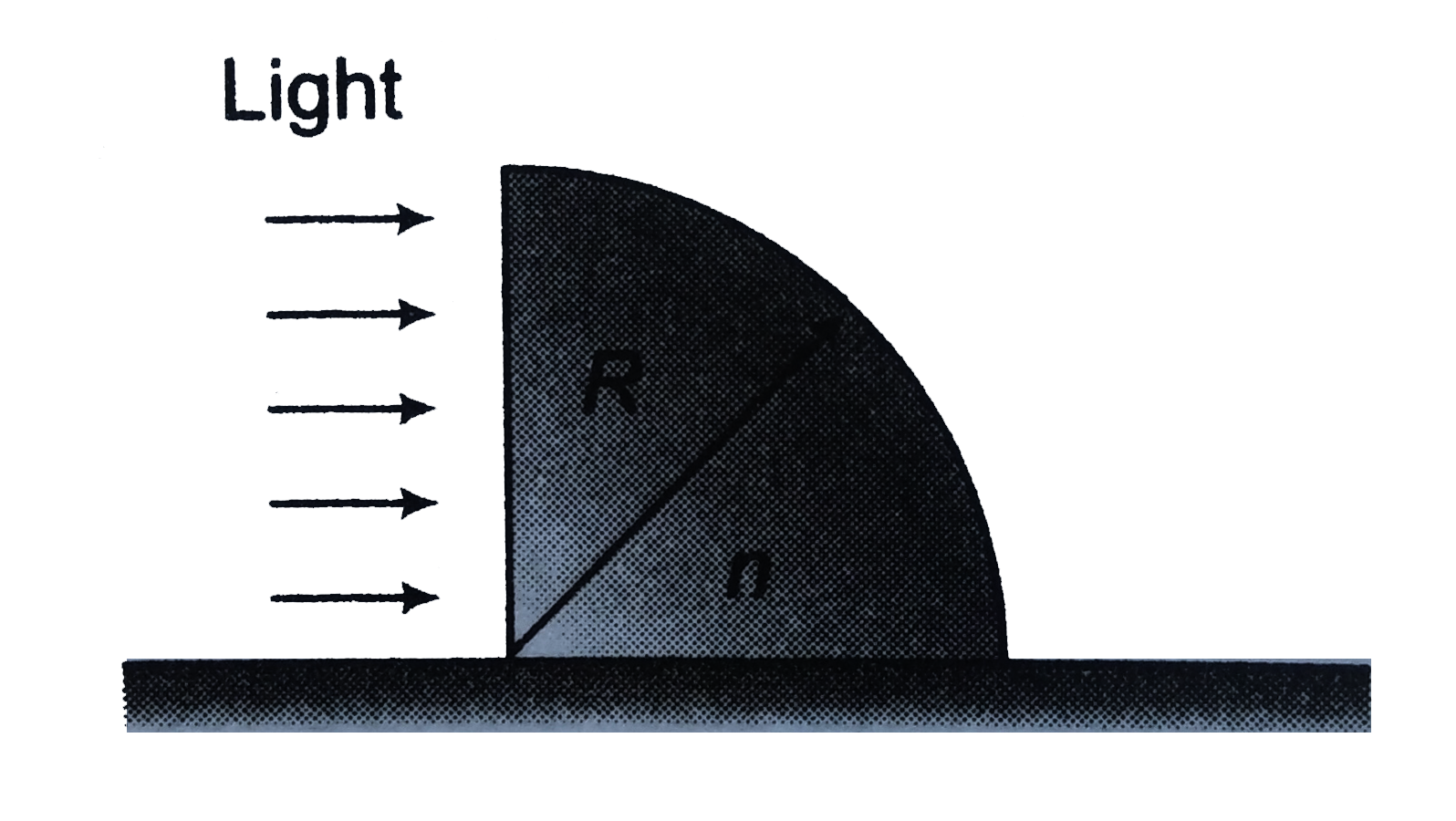 View Solution
View SolutionQuestion 101
A glass sphere has radius of 5.0cm and a refractive index of 1.6. A paperweight is constructed by slicing through the sphere on a plate that is 2.0cm from the centre of the sphere and perpendicular to radius of the sphere that passes through the centre of the circle formed by the intersection of the plane and the sphere. The paperweight is placed on a table and viewed from directly above an observer who is 8.0cm from the table top, as shown in figure. When viewed through the paperweight, how far away does the table top appear to the observer?View SolutionQuestion 104
Two glasses with refractive indices of 1.5and1.7 are used to make two indentical double convex lenses.
Find the ratio between their focal lengths.
How will each of these lenses act on a ray parallel to its optical axis if the lenses are submerged into a transparent liquid with a refractive index of 1.6?View SolutionQuestion 105
A converging beam of rays is incident on a diverging lens. Having passed through the lens the rays intersect at a point 15cm from the lens. If the lens is removed, the point where the rays meet, move 5cm closer to the mounting that holds the lens. Find the focal length of the lens. View SolutionQuestion 108
Determine the position of the image produced by an optical system consisting of a concave mirror with a focal length of 10cm and a convergent lens with a focal length of 20cm. The distance from the mirror to the lens is 30cm and from the lens to the object is 40cm. Consider only two steps. Plot the image.View SolutionQuestion 109
A parallel beam of rays is incident on a consisting pf three thin lenses with a common optical axis. The focal length of the lenses are equal to f1=+10cmandf2=−20cm,andf3=+9cm respectively. The distance between the first and the second lens is 15cm and between the second and the third is 5cm. Find the position of the point at which the beam converges when it leaves the system of lenses. View SolutionQuestion 110
A point source of light S is placed at the bottom of a vessel containg a liquid of refractive index 5/3. A person is viewing the source from above the surface. There is an opaque disc of radius 1cm floating on the surface. The centre of the disc lies vertically above the source S. The liquid from the vessel is gradually drained out through a tap. What is the maximum height of the liquid for which the source cannot at all be seen from above?View SolutionQuestion 112
A ray of light is incident on the left vertical face of glass cube of refractive index n2, as shown in figure. The plane of incidence is the plane of the page, and the cube is surrounded by liquid (refractive index=n1). What is the largest angle of incidence θ1 for which total internal reflection occurs at the top surfaces? View Solution
View SolutionQuestion 118
An achromatic lens-doublet is formed by placing in contact a convex lens of focal length 20cm and a concave lens of focal length 30cm. The dispersive power of the material of the convex lens is 0.8. Determine the dispersive power of the material of the concave lens. Calculate the focal length of the lens-doublet. View SolutionQuestion 123
Consider the situation as shown in figure. The point O is the centre. The light ray forms an angle of 60∘ with the normal.

The normal makes an angle 60∘ with the horizontal and the mirror makes an angle 60∘ with the normal. The value of refractive index of that spherical portions, so that light ray retraces its path isView SolutionQuestion 137
An object O is kept in air in front of a thin plano-convex lens of radius of curvature 10cm. Its refractive index at 3/2 and the medium towards right of the plane surface is water of refractive index 4/3. What should be distance x of the object so that the rays becomes parallel finally?
 View Solution
View SolutionQuestion 154
A flat glass slab of thickness 6cm and index 1.5 is placed in front of a plane mirror. An observer is standing behind the glass slab and looking at the mirror. The actual distance of the observer from the mirror is 50cm. The distance of his image from himself, as seen by the observer is View SolutionQuestion 156
A cubical block of glass of refractive index n1 is in contact with the surface of water of refractive index n2. A beam of light is incident on vertical face of the block. After refraction a total internal reflection at the base and refraction at the opposite face take place. The ray emerges at angle θ as shown. The value of θ is given by
 View Solution
View SolutionQuestion 168
A lense of focal length f is placed in between an object and screen at a distance D. The lens forms two real images of object on the screen for two of its different positions, a distance x apart. The two real images have magnification m1andm2 respectively (m1>m2). Choose the correct statement(s).View SolutionQuestion 169
A small angled prism of apex angle A=4∘ and refractive index μ=1.5 is placed in front of a vertical plane mirror as shown in figure. If the mirror is rotated through an angle θ, then the light ray becomes horizontal either after the mirror or after second time passing from the prism in opposite direction. The value θ is
 View Solution
View SolutionQuestion 170
A plano-convex lens P and a concavo-convex lens Q are in contact as shown in figure. The refractive index o fthe material of the lens P and Q is 1.8and1.2 respectively. The radius of curvature of the concave surface of the lens Q is double the radius of curvature of the convex surface. The convex surface of Q is silvered.

An object is placed on the placed on the principal axis at a distance 10cm form the plane surface. The image is formed at a distance 40cm from the plane surfaces on the same side. The focal length of the system is View SolutionQuestion 171
A plano-convex lens P and a concavo-convex lens Q are in contact as shown in figure. The refractive index o fthe material of the lens P and Q is 1.8and1.2 respectively. The radius of curvature of the concave surface of the lens Q is double the radius of curvature of the convex surface. The convex surface of Q is silvered.The focal lengthof combination is 8cm. The radius of curvature of common surface is
View SolutionQuestion 172
A plano-convex lens P and a concavo-convex lens Q are in contact as shown in figure. The refractive index o fthe material of the lens P and Q is 1.8and1.2 respectively. The radius of curvature of the concave surface of the lens Q is double the radius of curvature of the convex surface. The convex surface of Q is silvered.

The radius of curvature of common surface is View SolutionQuestion 175
In Figure, a fish watcher watches a fish through a 3.0 cm thick glass wall of a fish tank. The watcher is in level with the fish, the index of refraction of the glass is 8/5 and that of the water 4/3 .
a. To the fish, how far away does the watcher appear to be ?
b. To the watcher, how far away does the fish appear to be ?
 View Solution
View SolutionQuestion 177
A convexo-convex has a focal length of f1=10cm. One of the lens surfaces having a radius of curvature of R=10cm is coated with silver. Construct the image of the object produced by the given optical system and determine the position of the image if the object is at a distance of a=15cm from the lens. Refractive index of lens =1.5. View SolutionQuestion 178
A lens with a focal length of f=30cm produces on a screen a sharp image of an object that is at a distance of a=40cm from the lens. A plane parallel plate with thickness of d=9cm is placed between the lens and the object perpendicular to the optical axis of the lens. Through what distance should the screen be shifted for the image of the object to remain distinct? The refractive index of the glass of the plate is μ=1.8.View SolutionQuestion 179
One side of radius of curvature R2=120cm of a convexo-convex lens of material of refractive index μ=1.5 and focal length f1=40cm is slivered. It is placed on a horizontal surface with silvered surface in contact with it. Another convex lens of focal length f2=20cm is fixed coaxially d=10cm above the first lens. A luminous point object O on the axis gives rise to an image coincide with it. Find its height above the upper lens. View SolutionQuestion 180
A small object is placed on the principal axis of concave spherical mirror of radius 20cm at a distance of 30cm. By how much will the position of the image alter only after mirror, when a parallel-sided slab of glass of thickness 6cm and refractive index 1.5 is introduced between the centre of curvature and the object? The parallel sides are perpendicular to the principal axis. View SolutionQuestion 182
A glass hemisphere of radius 10cm and μ=1.5 is silvered over its curved surface. There is an air bubble in the glass 5cms from the plane surface along the axis. Find the position of the images of this bubble seen by observer looking along the axis into the flat surface of the atmosphere. View SolutionQuestion 183
A equilateral prism of flint glass (μg=3/2) is placed water (μw=4/3).
At what angle should a ray of light fall on the face of the prism so that inside the prism the ray is perpendicular to the bisector of the angle of the prism.
Through what angle will the ray turn after passing through both faces of the prism?View SolutionQuestion 185
The figure shows an arrangement of an equi-convex lens and a concave mirror. A point object O is placed on the principal axis at a distance 40cm from the lens such that the final image is also formed at the position of the object. If the radius of curvature of the concave mirror is 80cm, find the distance d. Also draw the ray diagram. The focal length of the lens in air is 20cm.
 View Solution
View SolutionQuestion 186
A convex lens is held 45cm above the bottom of an empty tank. The image of a point at the bottom of a tank is formed 36cm above the lens. Now, a liquid is poured into the tank to a depth of 40cm. It is found that the distance of the image of the same point on the bottom of the tank is 48cm above the lens. Find the refractive index of the liquid.View SolutionQuestion 187
A parallel beam of light falls normally on the first face of a prism of small angle .At the second face it is partly reflected,the reflected beam striking at the first face again, and emerging from it in a direction making an angle 6∘ 30' with the reversed direction of the incident beam. The refracted beam is found to have undergone a deviation of 1∘15' from the original direction.Find the refractive index of the glass and the angle of the prism.View SolutionQuestion 188
Two converging lenses of the same focal length f are separated by a distance 2f. The axis of the second lens is inclined at angle θ=60∘ with respect to the axis of the first lens. A parallel paraxial beam of light is incident from left side of the lens. Find the coordinates of the final image with respect to the origin of the first lens.
 View Solution
View SolutionQuestion 189
A cubical vessel with non-transparent walls is so located that the eye of an observer does not see its bottom but sees all of the wall CD.
To what height should water be poured into the vessel for the observer to see an object F arranged at a distance of b=10cm from corner D? The face of the vessel is a=40cm. Refractive index of water is 43.
 View Solution
View SolutionQuestion 190
A spherical ball of transparent material has index of refractionμ. A narrow beam of light AB is aimed as shown. What must the index of refraction be in order that the light is focused at the point C on the opposite end of the diameter from where the light entered? Given that x>>R.
 View Solution
View SolutionQuestion 192
A convex lens of focal length 15cm is split into two halves and the two halves are placed at a separation of 120cm. Between, the two halves of convex lens a plane mirror is placed horizontal and at a distance of 4mm below the principal axis of the lens halves. An object of length 2mm is placed at a distance of 20cm from one half lens as shown in figure.

Find the position and size of the final image.
Trace the path of rays forming the image.View SolutionQuestion 193
A cylinderical glass rod of radius 0.1m and refractive index √3 lies on a horizontal plane mirror. A horizontal ray of light moving perpendicular to the axis of the rod is incident on it. At what height from the mirror should the ray be incident so that it leaves the rod at a height of 0.1m above the plane mirror? At what centre to centre distance a second similar rod, parallel to the first, be placed on the mirror, such that the emergent ray from the second rod is in line with the incident ray on the first rod?
 View Solution
View SolutionQuestion 194
A transparent solid sphere of radius 2cm and density ρ floats in a transparent liquid of density 2ρ kept in a beaker. The bottom of the beaker is spherical in shape with radius of curvature 8cm and is silvered to make it concave mirror as shown in the figure. When an object is placed at a distance of 10cm directly above the centre of the sphere C, its final image coincides with it. Find h (as shown in the figure ), the height of the liquid surface in the beaker from the apex of the bottom. Consider the paraxial rays only. The refractive index of the sphere is 3/2 and that of the liquid is 4/3.
 View Solution
View SolutionQuestion 195
A hollow sphere of glass of inner and outer radii R and 2R respectively has a small mark on its inner surface. This mark is observed from a point outside the sphere such that the centre of the sphere lies in between. Prove that the mark will appear nearer than it really it, by a distance (μ−1)(R)/(3μ−1)View SolutionQuestion 196
A ray of light is refracted through a sphere whose material has a refractive index μ in such a way that it passes through the extremities of two radii which make an angle β with each other. Prove that if α is the deviation of the ray caused by its passage through the sphere, then
cos(β−α2)=μcos(βα)View SolutionQuestion 198
A glass rod has ends as shown in figure. The refractive index of glass is μ. The object O is at a distance 2R from the surface of larger radius of curvature. The distance between apexes of ends is 3R. Find the distance of image formed of the point object from right hand vertex. What is the condition to be satisfied if the image is to be real?
 View Solution
View SolutionQuestion 199
A convex lens of focal length 1.5m is placed in a system of coordinate axis such that its optical centre is at origin and principa, axis coinciding with the x-axis. An object and a plane mirror are arrange on theh principal axis as shown in figure. Find value of d (in m) so that y-coordinate of image (after refraction and reflection ) is 0.3m. (Take tanθ=0.3)
 View Solution
View Solution
All Exercises from DC PANDEY ENGLISH Class 12 PHYSICS REFRACTION OF LIGHT
- EXERCISE 31.1
- EXERCISE 31.2
- EXERCISE 31.4
- EXERCISE 31.5
- EXERCISE 31.6
- EXERCISE 31.7
- EXERCISE 31.8
- INTRODUCTORY EXERCISE
- LEVEL 1 ASSERTION AND REASON
- LEVEL 1 OBJECTIVE
- LEVEL 1 SUBJECTIVE
- LEVEL 2 COMPREHENSION BASED
- LEVEL 2 MORE THAN ONE CORRECT
- LEVEL 2 SINGLE CORRECT
- LEVEL 2 SUBJECTIVE
- MORE THAN ONE CORRECT OPTION
- OBJECTIVE QUESTIONS
- SINGLE CORRECT OPTION
- SUBJECTIVE QUESTIONS
- EXAMPLE
- EXAMPLE TYPE 10
- EXAMPLE TYPE 11
- SOLVED EXAMPLE










